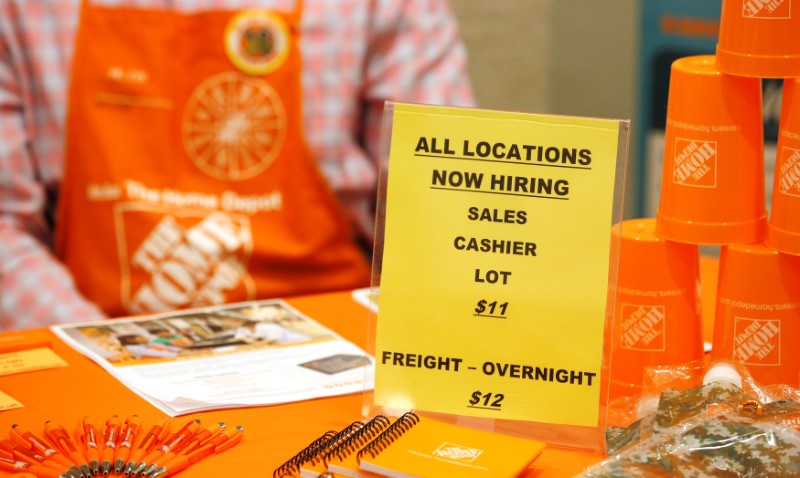By Lucia Mutikani
WASHINGTON (Reuters) – U.S. consumer prices increased modestly in April, pointing to a steady buildup of inflation that will likely keep the Federal Reserve on a path of gradual monetary policy tightening.
Price pressures could soon get a boost from a tightening labor market. Other data on Thursday showed new applications for unemployment benefits holding near more than a 48-year low last week.
Inflation is flirting with the U.S. central bank’s 2 percent target. Fed policymakers have in recent days signaled they would not be too concerned if inflation overshot the target, reiterating what the central bank said in its latest policy statement last week.
The Labor Department said its Consumer Price Index rose 0.2 percent as increases in the cost of gasoline and rental accommodation were tempered by a moderation in healthcare prices. The CPI had slipped 0.1 percent in March.
In the 12 months through April, the CPI increased 2.5 percent, the biggest gain since February 2017, after rising 2.4 percent in the comparable period in March.
Excluding the volatile food and energy components, the CPI edged up 0.1 percent after two straight monthly increases of 0.2 percent. The so-called core CPI rose 2.1 percent year-on-year in April, matching March’s increase.
Economists had forecast the CPI rebounding 0.3 percent in April and the core CPI climbing 0.2 percent.
The personal consumption expenditures price index excluding food and energy, which is the Fed’s preferred inflation measure, accelerated 1.9 percent year-on-year in March as last year’s big declines in the price of cell phone service plans dropped out of the calculation.
Economists expect the core PCE price index, which had increased 1.6 percent in February, to breach its target in May.
In their policy statement last week, Fed officials said they expected annual inflation to run close to the “symmetric” 2 percent target over the medium term. The central bank left interest rates unchanged last week.
The Fed hiked rates in March and has forecast at least two more increases for this year.
U.S. stock index futures added to gains after Thursday’s data and prices of U.S. Treasuries rose. The dollar <.DXY> added to losses against a basket of currencies.
GASOLINE PRICES RISING
Last month, gasoline prices rebounded 3.0 percent after tumbling 4.9 percent in March.
Further increases are likely after crude oil prices jumped to 3-1/2-year highs on Wednesday in the wake of President Donald Trump’s decision on Tuesday to pull the United States out of an international nuclear deal with Iran.
Food prices rose 0.3 percent last month, the largest increase in a year, after nudging up 0.1 percent in March. Food consumed at home increased 0.3 percent, the biggest gain since March 2017.
Owners’ equivalent rent of primary residence, which is what a homeowner would pay to rent or receive from renting a home, rose 0.3 percent last month after a similar gain in March.
But healthcare costs nudged up 0.1 percent after advancing 0.4 percent in March, helping to restrain the increase in the core CPI. Prices for used cars and trucks tumbled 1.6 percent in April, the largest drop since March 2009.
The cost of recreation fell 0.4 percent last month, the biggest decline since December 2009. There were also decreases in the cost of airline tickets, new motor vehicles and communications. The cost of motor vehicle insurance fell for the first time in a year.
Apparel prices rose 0.3 percent in April after falling 0.6 percent in the prior month. Prices for household furniture increased 0.5 percent last month, the largest rise since April 2015.
In a second report on Thursday, the Labor Department said initial claims for state unemployment benefits were unchanged at a seasonally adjusted 211,000 for the week ended May 5. Claims dropped to 209,000 during the week ended April 21, which was the lowest level since December 1969.
The labor market is considered to be near or at full employment, leading to a slowdown in job growth as employers struggle to find skilled workers. A government report on Tuesday showed job openings rising to a record 6.6 million in March.
Competition for workers is expected to push up wage growth, which has remained moderate.
Hiring slowed in March and April after surging in February. The unemployment rate dropped to near a 17-1/2-year low of 3.9 percent in April from 4.1 percent in March. The jobless rate is within striking distance of the Fed’s forecast of 3.8 percent by the end of this year.
(Reporting by Lucia Mutikani; Editing by Paul Simao)



















